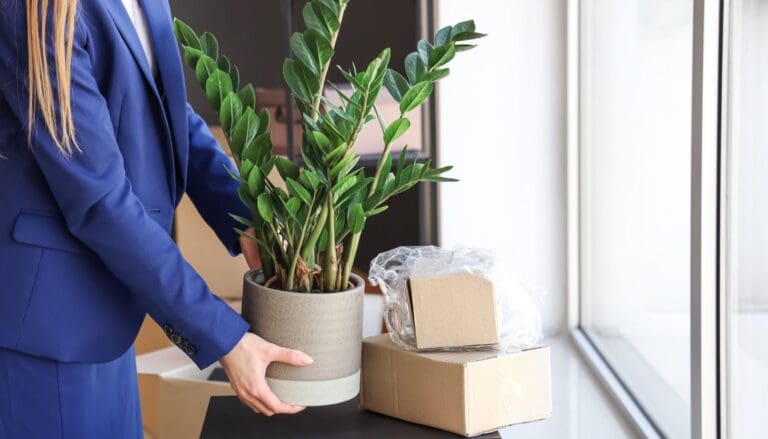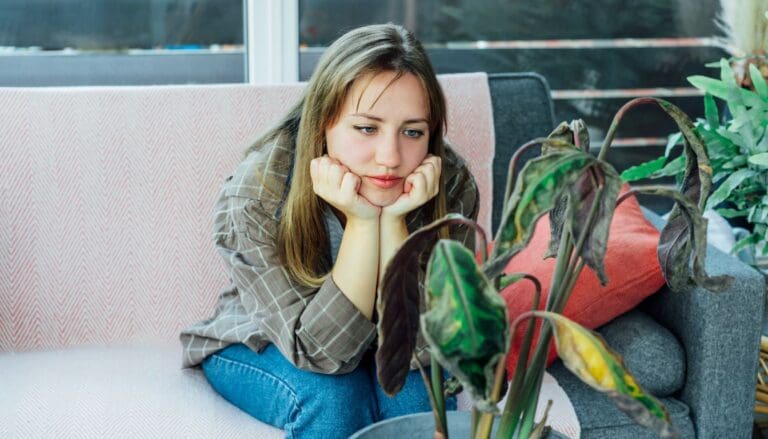4 Signs Your Plant Isn’t Adjusting to Fall Indoors
As the days get shorter and the chill creeps in, I’ll admit, moving my plants indoors for fall is always a little nerve-wracking. Sometimes, they just seem a bit sulky about the whole thing.
Spotting the signs that my plant isn’t loving its new indoor digs helps me step in before things get out of hand. I want my plants to look good all year, so I keep an eye out for any weird changes after I bring them inside.
Please note: Simplify Plants is reader-supported. As an Amazon Associate, I earn from qualifying purchases made by our readers with no extra cost added to you all! Some links in the post are affiliate links and I get a commission from purchases made through links in the post.
1) Drooping or curling leaves despite regular watering

I’ve noticed my plant’s leaves droop or curl even when I’m watering regularly. It’s a little frustrating, especially when the soil still feels damp.
Drooping leaves are usually my plant’s way of saying it’s not thrilled about being indoors in fall. The jump from outdoor sunshine to indoor light is a big adjustment.
Plants might react to less sunlight and cooler air by sagging or curling their leaves. Even with my usual watering routine, they can still look sad if they’re not getting enough light.
I check if the leaves feel soft or limp. Healthy leaves should feel firm and look lively.
Limp or curled leaves often mean the roots aren’t pulling up water properly. This can happen when my plant’s just plain stressed from the move.
Sometimes, I realize I’ve been a bit heavy-handed with watering. Overwatering is a classic mistake when plants come inside, especially once it’s cooler. The soil can stay soggy for ages, and that’s not great for roots.
I keep an eye out for these leaf signs after every watering. If I spot drooping or curling, I’ll move the plant closer to a window or add a grow light. That usually perks it up.
2) Yellowing leaves that don’t improve over time

One thing I always notice is yellowing leaves that just won’t go away. Sure, a leaf turning yellow and dropping happens sometimes, but if it keeps happening, something’s off.
If I keep seeing more yellow leaves, or it spreads week after week, it’s usually a sign my plant’s not happy indoors. That’s a clue I don’t ignore.
Moving my plant to a brighter spot can help. Plants can start to yellow if they’re not getting enough sunlight inside.
Shorter days in fall make this even trickier. Overwatering is another culprit.
When I bring my plant in, I try to remember it doesn’t need as much water as it did outside. Too much water can rot the roots and cause persistent yellow leaves. If the soil feels soggy, I back off on watering.
I also check for pests or dry air, since both can make leaves yellow and the plant look miserable. I peek under the leaves and feel if the air’s too dry.
If yellowing stops after I fix the light or watering, I know I’m on the right track. If not, my plant probably needs more help settling in.
3) Stunted growth compared to previous months
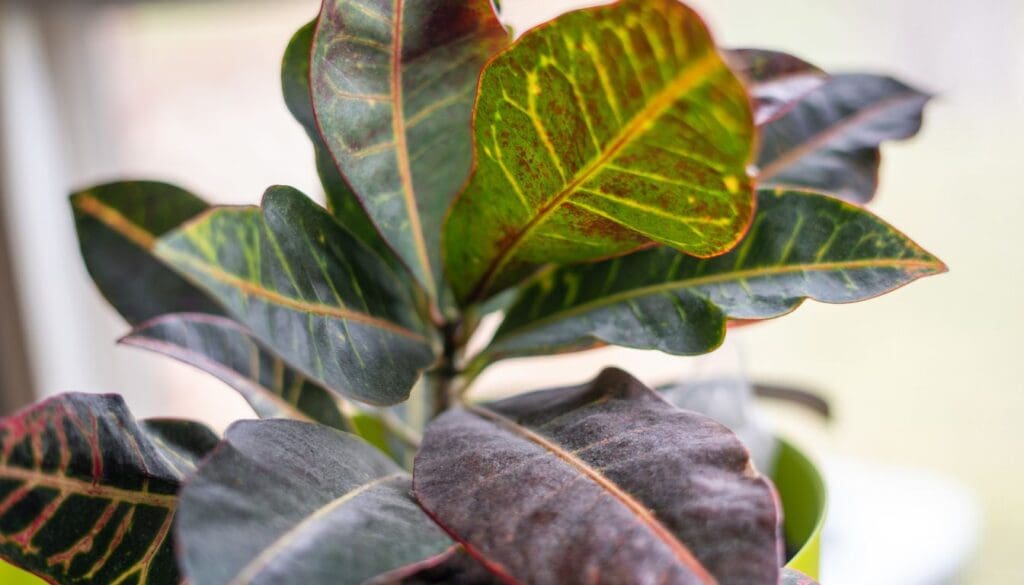
I’ve noticed that when my plants stop growing as fast as they did in summer, something’s up. Stunted growth is pretty common when I move a plant inside for fall.
If new leaves aren’t popping up or they’re staying tiny, my plant’s probably having trouble adjusting. The drop in sunlight inside is a big reason.
Less natural light, less growth—it’s just how it goes. Plants need sun to make food, so if they’re not getting enough, they slow down.
Indoor air can be drier or cooler, too, which doesn’t help. I check if the plant’s too close to a cold window or vent.
Watering can be tricky. Overwatering or underwatering both slow things down. I always poke the soil before I water.
If there’s no new growth for a month or two, I look for other signs like yellow leaves or drooping stems. Stunted growth plus those other signs means my plant needs a little TLC.
I’ll try a brighter spot or a grow light. Sometimes that’s all it takes.
Making small tweaks can really help my plant get back on track, even as the seasons shift.
4) Brown leaf tips or edges appearing suddenly
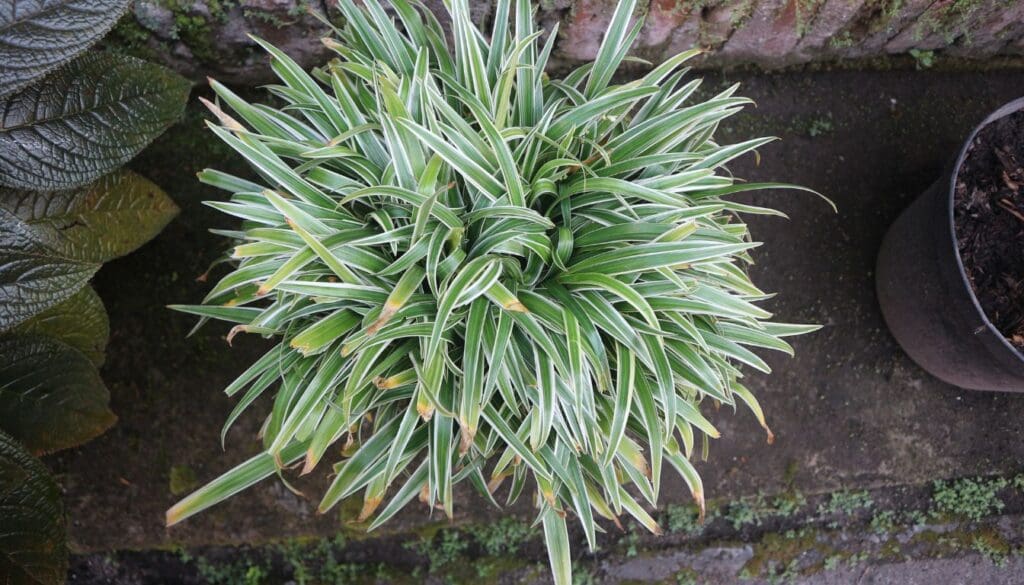
I see brown tips or crispy edges on my plants’ leaves pretty quickly after bringing them inside. It’s like, one day they’re fine, and the next—bam, brown edges.
These dark spots don’t always happen overnight, but they can show up fast. If I spot this on several leaves, I know I need to pay attention.
Dry indoor air is usually the main culprit. Once the heater’s on, my home gets drier and the plants lose moisture faster.
Watering mistakes can also play a part. Too much or too little water, and the roots start to struggle, which means brown leaf tips. I check the soil before I water, just to be sure.
Plants don’t always love sudden changes. Moving them inside can be a shock, especially if they were thriving outdoors.
Sudden temperature swings and low humidity can make those brown edges appear. I try to help my plants adjust slowly, keeping them away from heaters and drafts.
If my place is dry, I’ll run a humidifier or bunch my plants together for a humidity boost. When I catch brown tips early, it’s usually easy to fix.
I snip off the worst bits with clean scissors and watch for new stress signs. Healthy leaves mean my plant’s settling in.
If brown tips keep popping up, I look for patterns and tweak watering or move the plant. That way, I can help it thrive indoors all fall.
Understanding Plant Stress During Seasonal Transitions
When fall hits, my indoor plants definitely notice. The changes in light and water can stress them out, so it helps to know what to look for.
How Light Changes Affect Indoor Plants
Once my plants are inside, they get way less sunlight. Light from windows just isn’t the same as outdoor sun.
Some leaves might turn yellow or drop if the plant’s not getting enough. I try to put my plants by the brightest window I’ve got.
If that’s not cutting it, I’ll use a grow light for a few hours. Rotating the plant every week helps all sides get a shot at the light.
Without enough, plants can get leggy and weak. Here’s what I do to help:
- Wipe dust off windows and leaves.
- Keep curtains open during daylight.
- Move plants closer to the light, but not into cold drafts.
Watering Adjustments for Autumn Months
My plants honestly drink less in fall than in summer. Shorter, cooler days mean the soil dries out slower.
Overwatering is a super common mistake and leads to droopy, yellow leaves or root rot. I stick my finger in the soil—if the top inch is dry, I water.
Some plants need even less, so I wait longer between waterings for those. I also dump out any water that collects in trays under pots.
Here’s what I look for:
- Wilted or mushy stems usually mean too much water.
- Crispy leaves can mean my plant needs more water or humidity.
- Always use pots with drainage holes to keep roots happy.
Creating a Fall-Friendly Indoor Environment
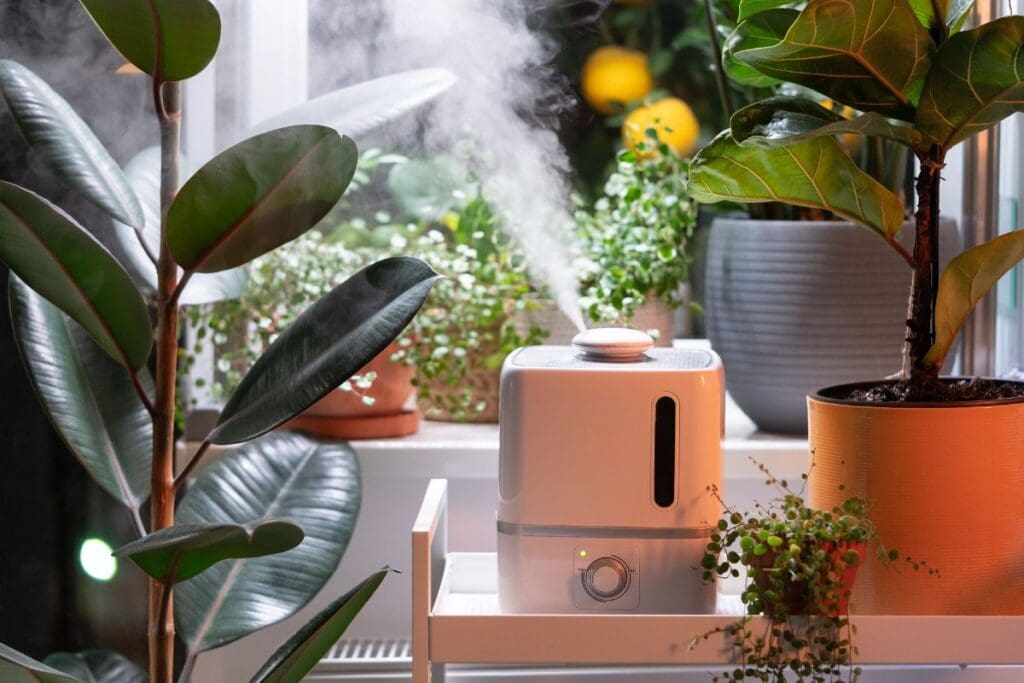
When I bring my plants inside for fall, they need a bit of extra care. Tweaking their setup helps them settle in faster and stay healthy.
Optimizing Temperature and Humidity
I try to keep my indoor temperature steady, around 65-75°F (18-24°C) during the day. Too much heat from radiators or cold drafts can really mess with my plants.
At night, I avoid letting temps drop below 60°F (16°C). Dry air from heaters makes leaves crispy.
I use a humidity tray or a small humidifier. Sometimes, I group plants together so they make a more humid microclimate.
I check soil more often since indoor air can dry it out faster than outside. Here’s how I handle the basics:
| Tip | Why It Matters |
|---|---|
| Keep temps above 60°F | Prevents shock and leaf drop |
| Add humidity | Stops leaf tips from browning |
| Avoid cold drafts | Reduces stress and leaf curling |
Choosing the Right Placement for Indoor Plants
I put my plants where they’ll get bright, indirect light. East- or north-facing windows are my go-tos in fall.
If a plant was in full sun outside, I move it a few feet back from the window—no one likes scorched leaves. Rotating plants every week helps all sides get some light.
I make sure none are too close to heat sources like vents, fireplaces, or radiators. Those dry them out fast and cause stress.
If I spot yellowing leaves, I check if the plant’s too far from light and move it closer. For bigger plants, a grow light can be a lifesaver.
Always double-check that each plant’s spot fits its light needs for fall.
Frequently Asked Questions
I see changes in my plants as the seasons shift. Brown tips or droopy leaves can worry me, so I like to know what’s going on and what to do.
How can I tell if my indoor plant is sick?
I look for wilting, yellowing, and brown edges on the leaves. Leaves that curl or drop are red flags, too.
If growth is way slower than before, that’s usually a sign my plant isn’t doing well.
What solutions exist for common indoor plant problems?
I tweak my watering routine and check that the soil drains well. Sometimes, I move the plant to get more or less light.
I’m always on the lookout for pests and remove them if I spot any.
What are the typical signs of diseases in indoor plants, and how can I treat them?
Spots, mushy stems, and a weird smell usually mean disease. I cut away any sick parts with clean scissors and avoid splashing water on the leaves.
If that doesn’t work, I’ll use a safe fungicide or insecticidal soap.
Why are my indoor plant’s leaves turning brown and crispy?
Brown, crispy leaves usually mean things are too dry or the air’s got low humidity. Over-fertilizing and salt build-up can do it, too.
I water a bit more and group my plants together to bump up the humidity.
How do I diagnose and cure a sick indoor plant?
First, I check the leaves and soil for pests or odd marks. Based on what I find, I might repot the plant, trim off sick bits, or adjust light and watering.
The faster I act, the better my plant’s chances of bouncing back.
Can I use an app to help determine my plant’s needs and issues?
Absolutely, I’ve tried out a few plant care apps myself. Some of them let you snap a picture of your plant and will toss back some advice—pretty handy, honestly.
They’re great for keeping tabs on watering or giving you a nudge when it’s time to care for your green buddies. A couple of the apps I’ve seen even flag potential pests or diseases, which is a relief if you’re not sure what you’re looking at.
Recommended Garden Supplies
| Product Image | Our Recommended Gardening Supplies | Check Offers! |
|---|---|---|
Top Top
Top
Top
Top
Top
Top
Top
Top | rePotme Houseplant and Tropical Classic Potting Soil Mix | Check Offer On Amazon |
 Top
Top
Top
Top
Top
Top
Top
Top | Espoma Organic Indoor Plant Food | Check Offer On Amazon |
 Top
Top
Top
Top
Top
Top
Top
Top | GooingTop LED Grow Light 6000K Full Spectrum Clip Plant Growing Lamp | Check Offer On Amazon |
 Top
Top
Top
Top
Top
Top
Top
Top | Soil Moisture Meter | Check Offer On Amazon |
 Top
Top
Top
Top
Top
Top
Top
Top | Govee Hygrometer Thermometer, Bluetooth Enabled! | Check Offer On Amazon |
 Top
Top | LEVOIT Humidifiers for Large Room(Best For Plants) | Check Offer On Amazon |
 Top
Top
Top
Top
Top
Top
Top
Top | Upgraded DIY Automatic Drip Irrigation Kit, 15 Potted Houseplants Support | Check Offer On Amazon |
 Top
Top
Top
Top
Top
Top
Top
Top | Stainless Steel Heavy Duty Gardening Tool Set | Check Offer On Amazon |
 Top
Top
Top
Top
Top
Top
Top
Top | Bonide Insecticidal Soap | Check Offer On Amazon |
 Top
Top
Top
Top
Top
Top
Top
Top | Bonide 32 oz Spray Neem Oil for Organic Gardening | Check Offer On Amazon |
 Top
Top
Top
Top
Top
Top
Top
Top | Garden Safe Fungicide | Check Offer On Amazon |



